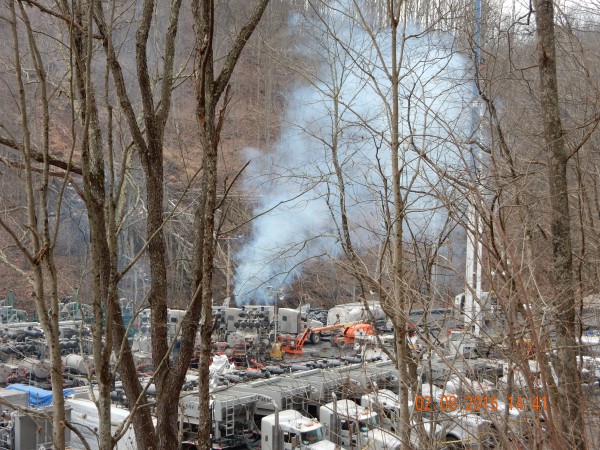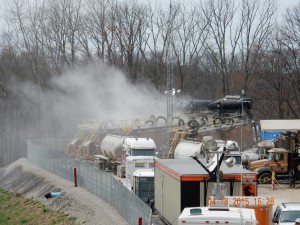- Like
- Digg
- Del
- Tumblr
- VKontakte
- Buffer
- Love This
- Odnoklassniki
- Meneame
- Blogger
- Amazon
- Yahoo Mail
- Gmail
- AOL
- Newsvine
- HackerNews
- Evernote
- MySpace
- Mail.ru
- Viadeo
- Line
- Comments
- Yummly
- SMS
- Viber
- Telegram
- Subscribe
- Skype
- Facebook Messenger
- Kakao
- LiveJournal
- Yammer
- Edgar
- Fintel
- Mix
- Instapaper
- Copy Link

Bill Hughes snapped this shot of a typical hydraulic fracturing site in the southeast part of Wetzel County, WV, where numerous trucks and pumps pour constant diesel fumes into the public air space. The huge trucks coming into and away from the site create dangers, noise and air pollution and infrastructure damage for the on narrow country roads. Hughes says, “Much serious thought should be given before communities permit this in their neighborhood.”
A near-constant stream of new studies is being released by scientists and health professionals that indicates major health problems for folks who live near unconventional oil and gas drilling (UOGD, aka “fracking) operations and the associated infrastructure and waste “disposal.”
Here’s a list of some resources and notes from research we’ve gathered recently:
SWPA Environmental Health Project
In June, OVEC volunteer Randi Pokladnik and I traveled to Pittsburgh to attend a conference titled Health and Shale Gas Development: State of the Science. The Southwest Pennsylvania Environmental Health Project (SWPA EHP) organized the conference, where Randi and I gained a lot of useful, but alarming, information.
Most of the health experts at the conference recommended that people live no closer than two miles from a UOGD operation. Families that include children and/or people with compromised immune systems and/or chemical sensitivities should remove themselves from any proximity to a nearby UOGD operation—at least on “bad weather” days and/or at times of high emissions from those operations.
UOGD sites are increasingly associated with chronic and acute health problems, including asthma exacerbation, skin rashes, headaches, sleep disturbances, and mental health issues. A wealth of information is posted on the SWPA EHP website, including resource kits, questionnaires, etc. for medical professionals.
OVEC has been in discussions with this organization regarding obtaining air quality monitors for people in WV who live near UOGD operations. Contact me at 304-522-0246 or robin@ohvec.org if you’d like more information on the air monitors.
League of Women Voters of Pennsylvania
Check out the League of Women Voters of Pennsylvania’s report: Shale Gas Extraction and Public Health: A Resource Guide.
This document gives an overview of multiple studies and public health official opinion polls that indicate numerous human, animal, and food supply problems associated with proximity to UOGD operations. The booklet raises some public policy issues, although many of these are specific to Pennsylania.
Moms Clean Air Force
If you surf over to Moms Clean Air Force, you’ll find awesome resource sheets on subjects such as Natural Gas and Air Pollution, How Oil and Gas Operations Impact Your Baby’s Health, Ozone, and Methane Leaks: Harmful, Wasteful and Preventable; Much BIGGER than a Fracking Problem. West Virginia lacks an organized chapter of this group; is anyone interested in that effort? If so, contact me at 304-522-0246 or robin@ohvec.org.
And More Groups with Loads of Info
Damascus Citizens for Sustainability focuses on multiple issues but includes many groundbreaking scientific and health studies on this link.
The Alliance of Nurses for Healthy Environments (ANHE) is a professional nursing group that seeks to bring multiple environmental health concerns into general discussions of human health. Their website has an alphabetical list of multiple environmental pollution sources, many of which are related to UOGD operations.
The Endocrine Disruption Exchange (TEDX) was originated by Dr. Theo Colburn, and has been conducting foundational research into a number of sources of endocrine disrupting chemicals for decades. Most recently, the exchange has focused on health effects associated with exposure to these chemicals in UOGD settings. This link gives you access to three webinars associated with that subject, including one focused on prenatal risks associated with pollutants from UOGD operations.
Here are my notes from a June 2 TEDX webinar, presented by Nicole C. Deziel, PHD, MHS, who is an Assistant Professor Yale School of Public Health.
LIMITED EPIDEMIOLOGIC STUDIES Childhood leukemia (null) (Fryzek et al. 2013) Self-reported dermal and respiratory irritation (Rabinowitz et al. 2014) Hospitalizations (Jemielita et al. 2015) Perinatal outcomes (McKenzie et al. 2014, Stacy et al. 2015, Casey et al. 2015)
CHALLENGES IN EXPOSURE ASSESSMENTS Wells treated as collective sources >1000 potential water/air pollutants. Wide range in physicochemical properties. Incomplete disclosure of agents. Emerging, but limited, measurements of health-relevant chemicals. Other facilities may also be significant sources.
Out of more than 1000 water-borne fracking chemicals, only slightly over 200 had any publicly available toxicity or water control standard information available.
82% of those water-borne chemicals tested (192) had developmental toxicity potential (see slide #17).
EXAMPLE CHEMICALS Examples from fracturing fluids: 1,2-propanediol, acrolein, bisphenol-A, and chlorine dioxide Examples from wastewater: metals (e.g., arsenic, cadmium, lead, and mercury) polycyclic aromatic hydrocarbons (e.g., benzo(a)pyrene) volatile organic compounds (e.g., benzene and toluene) other organics (e.g., di(2-ethylhexyl) phthalate and dibutyl phthalate)
CONCLUSIONS:
Constituents of fracturing fluids and waste water are linked to reproductive and developmental toxicity.
Limited toxicity information is available for many substances.
Carefully designed, rigorous exposure and epidemiological studies are urgently needed.
The 67 chemicals possibly associated with reproductive or developmental toxicity with a current or proposed drinking water standard or health-based guideline represent a feasible starting point for evaluation in future drinking water exposure studies or human health studies, particularly with respect to these outcomes
Further prioritization could be achieved with inclusion of environmental measurements from specific geographic regions of interest, as those data become available, and information on physicochemical properties and toxicologic potency.










